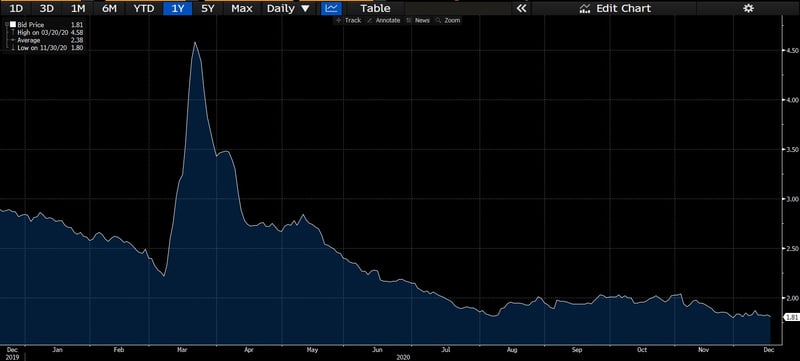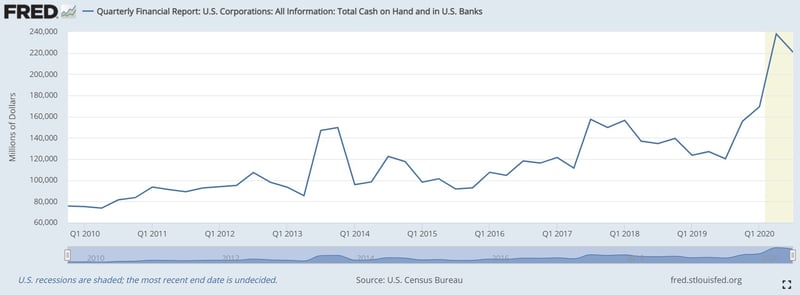 Today’s post comes to you from Rob Swanke, fixed income analyst on our Investment Management and Research team.
Today’s post comes to you from Rob Swanke, fixed income analyst on our Investment Management and Research team.
There has been some debate over the recent decision by the U.S. Department of the Treasury to ask the Fed to return unused CARES Act funding by December 31. Regardless of the politics involved, the decision shouldn’t necessarily be a concern for investors with a fixed income portfolio. But that doesn’t mean there are no implications to be considered regarding portfolio investments.
The specific programs ending are the Primary Market Corporate Credit Facility, the Secondary Market Corporate Credit Facility, the Municipal Liquidity Facility, the Main Street Lending Program, and the Term Asset-Backed Securities Loan Facility. There’s no need to remember these names, but it’s important to understand what these programs did for the markets, particularly the fixed income market.
An Effective Backstop
In March, the CARES Act created these programs to provide a backstop for the markets. They were intended to provide companies, municipalities, and some small businesses with the cash needed to survive the lockdowns, in case their normal sources of financing dried up due to investors pulling out of the market. Following the announcement of the programs, many didn’t go into effect for a few months. Nonetheless, their intended effect occurred immediately. The markets stabilized and companies were able to get market financing at reasonable interest rates. As shown in the chart below, yields on investment-grade corporate bonds fell from a high of 4.6 percent on March 20 to 2.7 percent on April 20. They continued to fall and, as of December 16, had dropped to 1.81 percent, just above the all-time low of 1.80% in November.
Investment-Grade Corporate Bond Yields
Source: Bloomberg Barclays U.S. Aggregate Bond Index, Corporate Yield to Worst
Just knowing these programs were available caused the market to step in. The majority of allocated funds was not put into action. In total dollars, the money loaned by the combined programs was just under $25 billion, according to the Fed’s most recent statement, made on November 30. Yet $1.95 trillion in program funding was initially allocated to these programs.
A Different Environment
Even though COVID-19 case counts are growing significantly in the U.S., prompting new shutdowns in certain states, the economic environment is different today than it was in March. At the start of the pandemic, uncertainty as to the length or breadth of the economic crisis was much higher. The backstop programs gave investors confidence that companies would be able to get financing if they needed it. Many firms were able to survive, particularly those that were healthy prior to the crisis. Now, although uncertainty still exists as to the toll of the virus, we have a good sense of the measures that governments will take to slow the pandemic and which industries will be most affected. Given the approval of effective vaccines, we also have a better sense of the potential length of the crisis. So, we can see that key differences now exist that affect the need for these CARES Act programs.
Corporate Survivability
What does this mean for the markets? Investors have more confidence that investment-grade companies will be able to survive. Even though some small businesses and high-yield companies may struggle to rebound, the time frame for the crisis is not a complete unknown. Also, during this time frame, many companies were able to prepare for a second wave of the virus. They accessed capital markets and refinanced or, with interest rates historically low, took on additional debt. According to Barclays, from March through November of this year, investment grade companies borrowed $1.4 trillion in debt, compared to only $788 billion during the same period in 2019. To be able to survive a slow period, companies kept a large amount of the funds borrowed in cash. The chart below from the St. Louis Fed shows the total cash on hand and in banks for U.S. corporations.

What Are the Implications Moving Forward?
Although the CARES Act backstop programs are closing, the Fed remains committed to using its traditional tools to support the markets. They include keeping short-term interest rates at 0 percent for several years and continuing to purchase Treasuries and agency mortgage-backed securities until we’re much closer to full employment. These tools will help keep interest rates down. That will help consumers be able to refinance their debt and have the confidence to continue spending. While the backstop programs will be gone, Congress could restart them if we get a significant shock to the markets. After all, we saw how effective they were in supporting businesses during the first crisis. Going forward, businesses will be judged on their ability to repay their loans over the long term. Given that investment-grade companies have mostly refinanced any debt coming due, they should continue to exhibit low default rates in the near term.
With fixed income yields falling so low, many investors may be looking to find investments that pay a reasonable income. When considering this strategy, it’s wise to keep a few things in mind. When moving away from short-term investments to get higher yields, you should consider the fundamentals of individual firms. Active management of fixed income can play a role here, given that the Fed may not support the entire market, especially lower-quality companies. For this reason, when looking for stability in the fixed income portion of your portfolio, you may want to consider higher-quality firms for longer-term investments.
As Warren Buffett said, “It’s only when the tide goes out that you learn who’s been swimming naked.” For now, however, we’re still at high tide in fixed income.


 Print
Print

